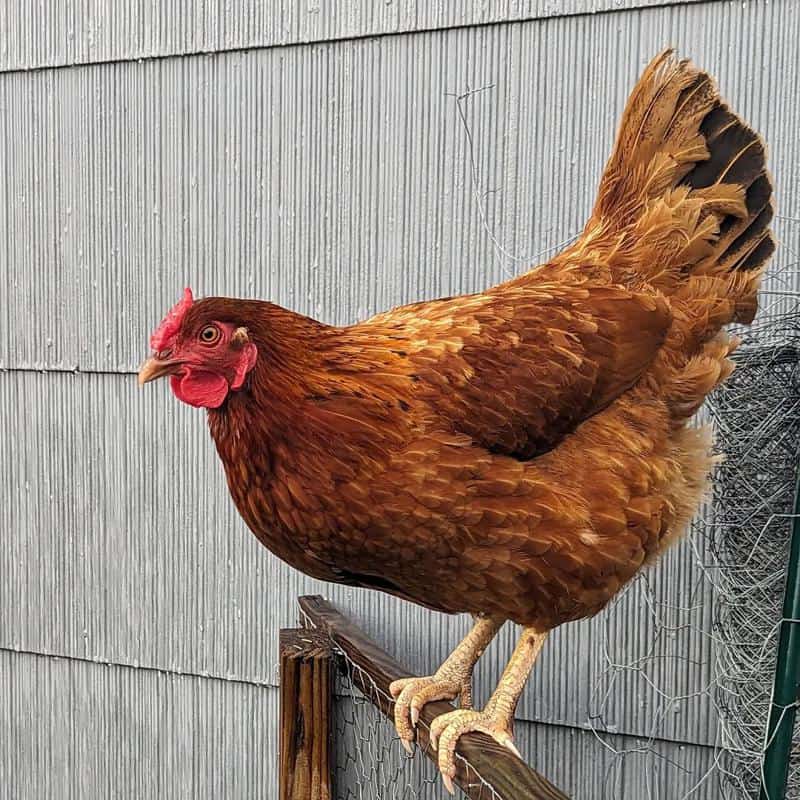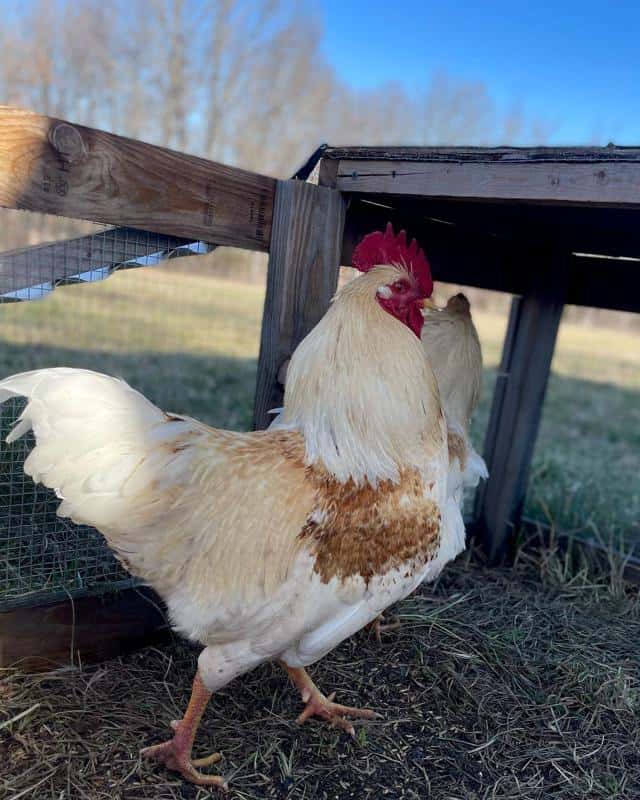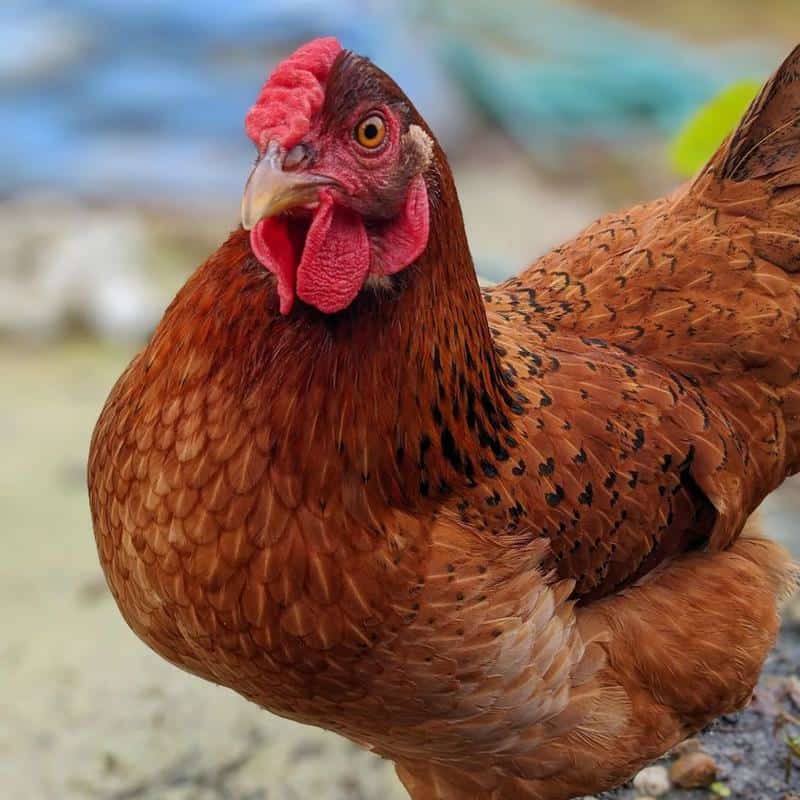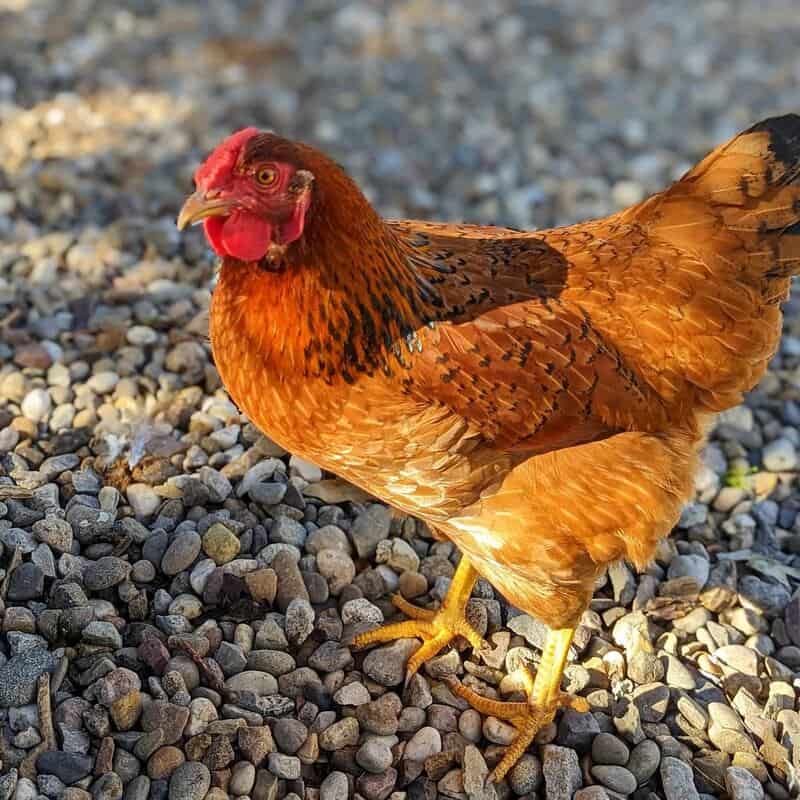Highly productive, docile, and relatively hardy, Cinnamon Queen chickens have many things going for them. This is why they are highly recommended for beginners to backyard chicken keeping.
Cinnamon Queens are not a heritage breed and are even younger than many well-known hybrids. However, the popularity of these chickens has been rising so fast that availability may be a challenge.
Caring for Cinnamon Queens is not a challenge, but this doesn’t mean you should do the bare minimum. Highly productive chickens such as these have demands that must be met to keep them productive and in great health.

Due to its appearance and other characteristics, the Cinnamon Queen is easy to confuse with other chicken breeds. However, if you know what to look for, you can ensure the chicken you get is always a Queen and nothing less.
Read on to find out exactly what these chickens can add to your backyard flock and if you’re ready to get one today.
Cinnamon Queen Quick Facts:
| Names | Cinnamon Queen |
| Origin | USA |
| Purpose | Egg Production |
| Egg Production/Year | 250 – 320 |
| Climate | Cold and Heat Hardy |
| Plumage Color | Red-Brown with some white feathering (hens) |
| Weight (Hens) | 6.5 lbs. |
| Personality | Docile/Non-Aggressive |
| Unique Fact | Don’t usually go broody but make good mothers. |
Origins of Cinnamon Queens
As a recently developed hybrid, the Cinnamon Queen doesn’t have much of a history. Additionally, as a commercial hybrid, the exact lineage of these birds is kept a secret so we may never know exactly which birds are bred to give us these amazing layers.
However, the trademark for the Cinnamon Queen name is held by an American Hatchery that claims the parent stock for its chicken is:
- A Rhode Island Red rooster (production type)
- A Rhode Island White hen (production type)
Additionally, the hatchery claims to be using its own proprietary strains of these breeds to develop its chickens.
Other sources state that these chickens are developed by crossing Hew Hampshire roosters with Silver-Laced Wyandotte hens. Keep in mind that New Hampshire roosters were derived exclusively from Rhode Island Red chickens.
This means that even though the Cinnamon Queens in the market today share many characteristics, they probably have different lineages depending on where they came from.
This also means that characteristics such as production potential may vary a little depending on where you source your birds. Despite these differences, there are enough similarities between these birds for them to share the Cinnamon Queen name.
Appearance of Cinnamon Queen Chickens
Cinnamon Queen chickens can either have a rose comb or a single comb depending on their lineage. As red sex-linked chickens, the roosters and the hens have significant differences in plumage colors.
Hens
Cinnamon Queen hens have plumage that is a mix of brown and red. Some hens will have a few white feathers in their tails and other body parts, but the cinnamon color is always prominent.
The weight of mature Cinnamon Queen hens ranges between 6 and 7 pounds. Pullets will be closer to 6 pounds.
Cinnamon Queen Roosters

In contrast to the females, the Cinnamon Queen rooster’s feathers are mostly white with the red-brown coloring showing up in just a few areas like the shoulders and the tails.
Some hatcheries claim their roosters can weigh as much as 9 pounds, while others put the maximum weight of their roosters at 7.5 pounds.
The Production Potential of Cinnamon Queens
How Many Eggs Can Cinnamon Queens Lay?
Many hatcheries claim that their lines of Cinnamon Queens can provide between 250 and 300 eggs. However, there are a few who say their Cinnamon Queens can provide as many as 320 eggs in just one year.
A range of 250 to 320 eggs in a year is wide but it makes sense given factors such as:
- Different strains of Cinnamon Queens will have slightly different characteristics.
- The conditions in which the hens are raised will vary from one farm to another. Factors such as diet, history of illness, and even lighting can contribute to different levels of productivity.
Regardless of the specific number, if you just want eggs for you and your family, a few Cinnamon Queens should be more than enough to meet your needs.
When Do Cinnamon Queens Start Laying?
Cinnamon Queens are said to start laying eggs quite early compared to other types of chickens. Many farmers have stated that their chickens started laying at around 18 weeks while others have said the 20th week is when things start.
However, some farmers have had to wait a few more weeks to see the first eggs from their Cinnamon Queens. Just like with their production numbers, your Queens may start laying late due to factors such as the quality of their feed, poor lighting conditions, poor housing, and poor health.
How Long Before Production Falls Off?
Cinnamon Queens, like other top layers, are very prolific in their early years. However, by their second year, production may be down 10 to 20 percent although the size of the eggs may be bigger.
In the third and fourth years, the decline in production is quite dramatic. This is why many farmers will harvest their hens after two years.
Your Cinnamon Queens will also lay fewer eggs when they undergo molting. This usually takes place towards the end of summer.
How Big are the Eggs from Cinnamon Queens?
The eggs from Cinnamon queens are classified as large or extra-large. According to US standards, this means the eggs range from 56.8g(2 oz.) to 63.8g(2.25oz).
The eggs are brown in color.
Are Cinnamon Queens Any Good for Meat?
A common complaint about very productive layers is that they are too small to make good meat birds. However, this isn’t necessarily the case with Cinnamon Queens.
A mature cinnamon queen hen can weigh in the range of 5.5 to 6 pounds. This means they are mid-sized and large enough to yield a meaty carcass.
Some hatcheries actually list Cinnamon Queens as a dual-purpose hybrid. You can also get the Cinnamon Queen roosters from some places, and these should yield even more meat.
Accommodating Cinnamon Queens’ High Production Potential

A chicken with the high production numbers seen in Cinnamon Queens will have some special needs. These needs are important for sustaining higher levels of production while keeping the hens healthy.
Housing Needs of Cinnamon Queens
Cinnamon Queens do well in both hot and cold environments. These birds are used for production in countries with vastly different climates such as the US and Nigeria.
This hardiness is one of the factors that make these birds so popular. Other factors about Cinnamon Queens relating to their housing and environment that you should be aware of include:
- These birds were developed as commercial hybrids. This means that they can handle the stress of confinement well.
- Cinnamon Queens have also proven to be excellent foragers, and many have been converted to a free-range lifestyle.
- Factors such as crowding inside the coop can lead to stress which can lower your Cinnamon Queen’s productivity. Ensure your chickens have at least 4 square feet of space in the coop and around 15 square feet per chicken in the run.
- Still on the space issue, ensure you have enough nesting boxes for your hens. One nesting box should be able to accommodate three to four chickens.
Feeding a Cinnamon Queen
Putting your Cinnamon Queens on the right diet is important both for egg production and the health of your chickens.
It’s important to have these chickens on the right diet even before they begin laying eggs. Once Cinnamon Queens start laying, their nutrient-rich diets should have a high protein level and extra calcium as well.
The feed should ensure the chickens never lack nutrients such as calcium. Medicated feed can also help to prevent the occurrence of some diseases such as Coccidiosis which are difficult to prevent even with the best hygiene practices.
Temperament of Cinnamon Queens
Cinnamon Queens are quite docile birds, and this is one of the reasons why they are considered very beginner friendly. They don’t mind being handled and are usually great around children.
The downside of their sweet disposition is that they can be picked on by more assertive or aggressive breeds.
You can prevent this by keeping a flock made up of Cinnamon Queens exclusively. Another alternative is to only keep them with breeds or hybrids that are similarly gentle.
What is the Lifespan of Cinnamon Queens?
One of the key downsides of keeping Cinnamon Queens is that these birds tend to have shorter lifespans than other chickens.
Cinnamon Queens, like other commercial hybrids, were developed to be very productive but only for short periods of time. Even if it isn’t harvested early, your Cinnamon Queen will have a lifespan of 4 to 6 years.
Reproductive issues due to their prolific egg-laying and the sizes of their eggs are some of the factors that contribute to their shorter lifespans.
There are some farmers who have reported their Cinnamon Queens living longer. The downside of this is that these chickens produce much fewer eggs after their second year and it may be expensive to keep one around afterward.
Breeding and Brooding in Cinnamon Queens
Broodiness
Cinnamon Queens will go broody on occasion, but this is certainly not the norm. Commercial layers are not usually designed to go broody since this would mean they won’t lay as many eggs.
Backyard farmers have noted that their Cinnamon Queens will go broody on occasion and also make very good mothers when the opportunity arises.
Can You Breed Your Own Cinnamon Queens?
Cinnamon Queens are hybrids. This means that the offspring of two Cinnamon Queens will not be a Cinnamon Queen.
The only way for a backyard farmer to get a Cinnamon Queen is to buy one from a hatchery or some other source.
Even with the correct parent breeds, it is unlikely the chickens will be from the same line used by hatcheries to get their Cinnamon Queens. Therefore, your hybrids could have significantly different characteristics.
You can also get Cinnamon Queen eggs from some hatcheries. These are not eggs from Cinnamon Queen hens but eggs that will hatch Cinnamon Queen chicks.
What Does it Mean to be Sex-Linked?
One of the frequently cited advantages of Cinnamon Queens is that they are sex-linked, but what does this mean?
To be sex-linked means the sexes of the chicks can be differentiated soon after hatching. Female Cinnamon Queen chicks are almost always some sort of brown color while the males are usually white.
This is important because the chicks are sold very early. The last thing a farmer specializing in egg production wants is to spend time and money raising a chick that turns out to be a rooster.
Also Read: Best Brown Chicken Breeds
Comparing Cinnamon Queens vs Other Chicken Breeds
Cinnamon Queens vs Rhode Island Reds
As one of the parent breeds of the Cinnamon Queen, Rhode Island Reds share many characteristics with this hybrid. Rhode Island Reds are only slightly larger than Cinnamon Queens and they also lay large eggs.
However, Cinnamon Queens are typically better layers than Rhode Island Reds. Rhode Island Reds are also quite aggressive even towards humans.
You can tell these two apart because the Rhode Island Reds have plumage that is a deeper red with tails that are almost completely black. The plumage of the Cinnamon Queen is a lighter brown with white highlights.
Cinnamon Queens vs ISA Brown
Cinnamon Queens and ISA Browns are both red sex-link hybrids and these two hybrids are difficult to tell apart as they have similarly colored plumage. One notable difference is that mature Cinnamon Queens are slightly heavier than ISA Browns.
Another difference is that some Cinnamon Queens have rose combs whereas ISA Browns only have single combs.
These chickens have comparable egg production numbers and temperaments. However, they are developed and sold by different companies/hatcheries using different strains of specific breeds.
Cinnamon Queens vs Golden Comet
These two hybrids are also frequently confused with each other. They have similar plumage colors, and the hens also have similar production rates and temperaments.
Just like ISA Browns, Golden Comets can only have single combs but Cinnamon Queens can have either single or rose combs.
Availability of Cinnamon Queens
Although one hatchery is said to have trademarked the Cinnamon Queen name, you can get Cinnamon Queens from other sources including other hatcheries.
You can get female chicks for less than five dollars each. Some hatcheries also offer Cinnamon Queen eggs but only for limited periods during the year.
You should always ensure you’re dealing with a reputable supplier to ensure you’re getting Cinnamon Queens and not some other hybrids.
Read More:
A Queen Worthy of the Name
Red sex-link hybrids are becoming increasingly popular as backyard chickens. These birds include the Cinnamon Queen which produces enough eggs in a year to be placed in the same league as ISA Browns.
The Cinnamon Queen is a beginner-friendly hybrid that can handle different environments well. It has a docile temperament that makes it relatively easy to manage on the farm.
Different hatcheries use different combinations of parent breeds to produce their lines of Cinnamon Queens. This results in small differences in characteristics, but any bird with this name can be expected to produce 300 or more eggs under ideal conditions.
The diet and housing of the Cinnamon Queen must meet certain standards to keep them in good health. Even so, they have the shorter lifespans that are typical of hybrids.
Whether you are a beginner or an experienced chicken farmer, the Cinnamon Queen can be the egg-laying champ you need in your backyard.

